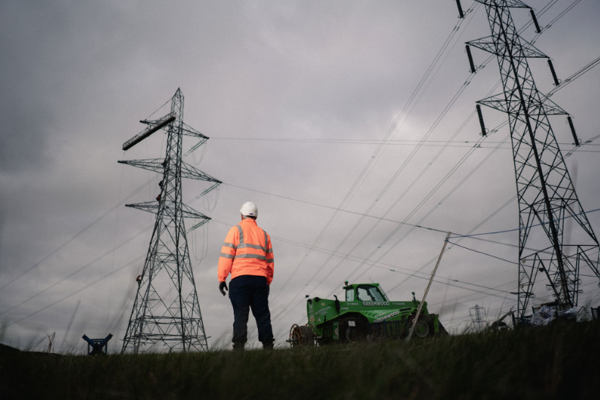- Energy
- 19 Mar 2025
Working on behalf of National Grid, work was needed to connect the southernmost T-pylons on the Hinkley Connection, which run from Horsey to the Huntspill River, onto the electricity network.

Working on behalf of National Grid, work was needed to update the electricity network in the south west to accommodate the new Hinkley Point C reactor coming online. The project was awarded in April 2020, with construction starting in February 2021, after receiving Development Consent Order (DCO) approval from the Local Planning Authority (LPA).
To modify the network, we needed to change and introduce three line entries from the old Hinkley Point B to the new Hinkley Point C via the Shurton Substation. One of these connections, the VQ route, also needed uprating to provide a 400kV link from Point C once it is built and online.
Works undertaken by our team included:
- Upgrading 57 towers of the VQ overhead line between Hinkley C and Bridgwater substation from 275kV to 400kV and the realignment of two overhead lines near Stogursey to cater for the energy from the new Hinkley Point C power station to the whole Hinkley Connection route.
- The construction of 13 new pylons to connect Hinkley C to the existing Overhead line near Stogursey and Bridgwater.
- The construction of 4 new pylons to enable the connection of T-pylons near Bridgwater to the existing and uprated 400kV line between Hinkley C and Bridgwater substation.
- The replacement of existing Conductor, earthwire and fittings and tower painting on the VQ overhead line route.
- Install of temporary works such as scaffolds to protect roads, access panels, access tracks and work platforms to facilitate the construction of new pylons and refurbishment of existing overhead line
- Deployment of Skysafe over conductors to protect M5 motorway, A38 Bristol Road, and railway lines during conductor replacement
- Upgrade pylon foundations and pylon steel strengthening to cater for the new and heavier conductor installed on the existing VQ overhead line.
- Reinstatement of all temporary works upon completion of permanent works.
The project was awarded under a Development Consent Order (DCO) that required extensive interaction with local planning authorities and other stakeholders to gain approval before work could commence.
The project started during Covid-19, which presented challenges including creating a resilience plan to make sure the project wasn’t impacted, as well as overcoming supply chain issues from overseas suppliers to meet the programme of works.
With the support of our supply chain partners, we rolled out innovative solutions using stabilised soil on access roads instead of traditional installation methods, reducing carbon emissions by 76%.
Our eco-friendly solar powered welfare unit was also used on the project, reducing carbon emissions by 86% compared to previously used welfare cabins.
The project is in its final phase. The temporary pylons were removed in late 2024, construction works are almost complete, with the final stages set to finish by Spring 2025.
Once completed, the energised lines will provide greater resilience across the network and ensure the capacity needed to connect low carbon, homegrown energy from Hinkley Point C to 6 million homes across the UK.




